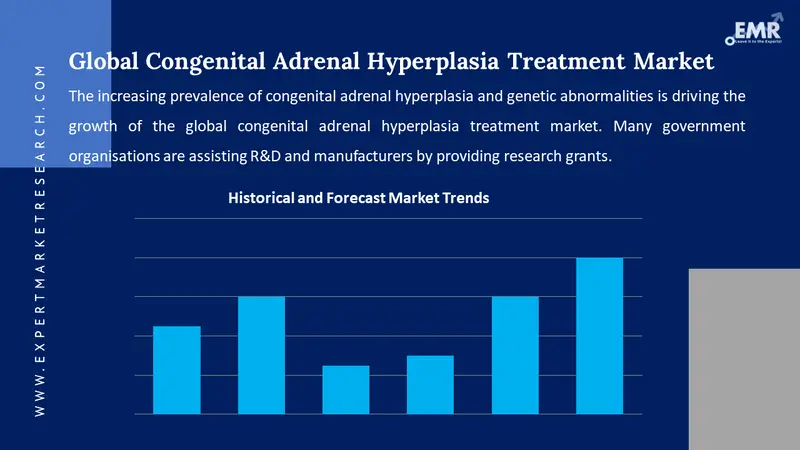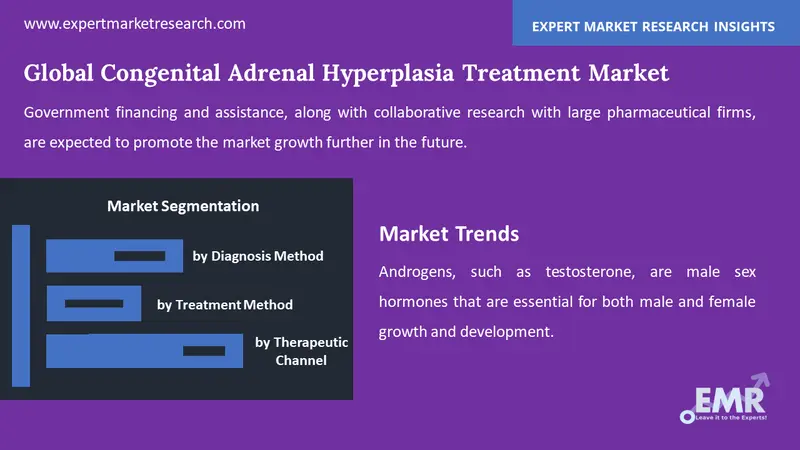
Consumer Insights
Uncover trends and behaviors shaping consumer choices today
Procurement Insights
Optimize your sourcing strategy with key market data
Industry Stats
Stay ahead with the latest trends and market analysis.
The congenital adrenal hyperplasia treatment market was valued at USD 478.36 Million in 2025 and is expected to grow at a CAGR of 7.60%, reaching USD 995.12 Million by 2035. The market is experiencing growth due to increasing awareness of endocrine disorders and demand for novel therapeutics.
Base Year
Historical Period
Forecast Period
Compound Annual Growth Rate
7.6%
Value in USD Million
2026-2035
*this image is indicative*
Congenital adrenal hyperplasia (CAH) is a collection of hereditary disorders affecting the adrenal glands, which are a pair of walnut-sized structures located above the kidneys. Important hormones produced by the adrenal glands include the following:

Read more about this report - REQUEST FREE SAMPLE COPY IN PDF
The most common cause of CAH is a deficiency in the enzyme 21-hydroxylase. CAH is also known as 21-hydroxylase deficiency. The body requires this enzyme to produce enough levels of hormones. Other, far uncommon enzyme deficits can also induce CAH.
Parents who have CAH or are carriers of the disorder’s genetic alteration are most likely to increase the chances of CAH prevalence.
95% of all CAH cases are of two categories which are classical congenital adrenal hyperplasia and non-classic congenital adrenal hyperplasia. The more dangerous form of CAH is known as classic CAH. It can result in adrenal problems such as shock and coma. It can be lethal if not detected and treated promptly and is often diagnosed at birth. Classic CAH is divided into two subtypes: Saltwasting CAH and Simple—virilizing CAH. On the other hand, non-classic CAH is the mildest form of CAH.
Classic congenital adrenal hyperplasia (CAH) produces excessive water and salt loss in the urine. People are at risk of significant consequences such as electrolyte imbalances like potassium. These imbalances, if left unchecked, can result in arrhythmia, cardiac arrest, and death.
Non-classic CAH might also cause difficulties if left untreated. It can result in the following symptoms in people who were assigned male at birth (AMAB) early onset of puberty and short stature. With people assigned female at birth (AFAB) include symptoms like permanent male physical traits, irregular menstruation, and infertility.

Read more about this report - REQUEST FREE SAMPLE COPY IN PDF
According to the congenital adrenal hyperplasia treatment market research report, the market can be categorised into the following segments:
Market Breakup by Diagnosis Method
Market Breakup by Treatment Method
Market Breakup by Treatment Channel
Market Breakup by Region
In the United States and Europe, 1 in every 10,000 to 15,000 persons has classic CAH. Non-classic CAH affects around 1 out of every 100 to 200 persons. CAH, both classic and non-classic, affects people all over the world. The prevalence of the salt-wasting type of this condition may be as high as 1 in 282 Yupik Eskimos. Other types of CAH are far more uncommon. Non-classical CAH, on the other hand, affects around 1 in 100 to 1 in 200 people in the general population.
The increasing prevalence of congenital adrenal hyperplasia and genetic abnormalities is driving the growth of the global congenital adrenal hyperplasia treatment market. Many government organisations are assisting R&D and manufacturers by providing research grants. The rising demand for better treatment and increased government backing has fuelled the growth of the global market. Government financing and assistance, along with collaborative research with large pharmaceutical firms, are expected to promote the market growth further in the future.
To lessen the symptoms of CAH, newborns with classic CAH should begin therapy as soon as possible after birth. Steroids are used to replace the low hormone levels in classic CAH. Hydrocortisone is a kind of cortisol that is commonly given to infants and children.
Adults are given hydrocortisone, prednisone, or dexamethasone to replace cortisol. Fludrocortisone is another medication used to substitute aldosterone in patients with classic CAH. Salt-wasters may benefit from eating salty foods or taking salt pills.
Patients with classic CAH must take medication on a regular basis for the rest of their lives. Symptoms will recur if a patient stops taking medication.
If a person has non-classic CAH and does not have symptoms, they may not require therapy. Individuals experiencing symptoms like early puberty, excess body hair, irregular menstrual periods, and infertility are given low doses of the same cortisol-replacement medicine as people suffering from typical CAH.
In the case of classic CAH, girls with ambiguous external genitalia may require surgery. For example, if genital alterations have impaired urine flow, surgery is required. Non-classic CAH girls have normal genitals and do not require surgery.
A few clinical studies on CAH treatment are presently in progress are as follows:
Alternative dosage forms of hydrocortisone are being offered or will be soon, although the cost could be a barrier to use, at least in the United States market. Corticotropin-releasing hormone receptor antagonists and androgen biosynthesis inhibitors are now being tested in clinical trials.
The report gives an in-depth analysis of the key players involved in the global congenital adrenal hyperplasia treatment market, sponsors manufacturing the drugs, and putting them through trials to get FDA approvals. The companies included in the market are as follows:




*While we strive to always give you current and accurate information, the numbers depicted on the website are indicative and may differ from the actual numbers in the main report. At Expert Market Research, we aim to bring you the latest insights and trends in the market. Using our analyses and forecasts, stakeholders can understand the market dynamics, navigate challenges, and capitalize on opportunities to make data-driven strategic decisions.*
Get in touch with us for a customized solution tailored to your unique requirements and save upto 35%!
The market is likely to grow at a CAGR of 7.60% during the forecast period of 2026-2035.
The market growth is being driven by the increasing prevalence of congenital adrenal hyperplasia and genetic abnormalities.
Based on the diagnosis, the market is categorised into prenatal testing, physical exam, blood and urine tests, and genetic testing, among others.
Based on the treatment, the market is segmented into medications, physical exams, and reconstructive surgery, among others.
The treatment channels in this market are public and private.
The different regions in the market are North America, Europe, Asia Pacific, Latin America and the Middle East and Africa.
The key companies involved in this market are Neurocrine Bioscience, Johnson and Johnson, Sanofi, Zydus Lifesciences Ltd., GSK plc, BridgeBio, Inc, Millendo Therapeutics, Inc., Spruce Biosciences, and EffRx Pharmaceuticals, among others.
Explore our key highlights of the report and gain a concise overview of key findings, trends, and actionable insights that will empower your strategic decisions.
| REPORT FEATURES | DETAILS |
| Base Year | 2025 |
| Historical Period | 2019-2025 |
| Forecast Period | 2026-2035 |
| Scope of the Report |
Historical and Forecast Trends, Industry Drivers and Constraints, Historical and Forecast Market Analysis by Segment:
|
| Breakup by Diagnosis Method |
|
| Breakup by Treatment Method |
|
| Breakup by Therapeutic Channel |
|
| Breakup by Region |
|
| Market Dynamics |
|
| Supplier Landscape |
|
| Companies Covered |
|
Datasheet
One User
USD 3,299
USD 2,969
tax inclusive*
Single User License
One User
USD 5,499
USD 4,949
tax inclusive*
Five User License
Five User
USD 6,999
USD 5,949
tax inclusive*
Corporate License
Unlimited Users
USD 8,199
USD 6,969
tax inclusive*
*Please note that the prices mentioned below are starting prices for each bundle type. Kindly contact our team for further details.*
Flash Bundle
Small Business Bundle
Growth Bundle
Enterprise Bundle
*Please note that the prices mentioned below are starting prices for each bundle type. Kindly contact our team for further details.*
Flash Bundle
Number of Reports: 3
20%
tax inclusive*
Small Business Bundle
Number of Reports: 5
25%
tax inclusive*
Growth Bundle
Number of Reports: 8
30%
tax inclusive*
Enterprise Bundle
Number of Reports: 10
35%
tax inclusive*
How To Order

Select License Type
Choose the right license for your needs and access rights.

Click on ‘Buy Now’
Add the report to your cart with one click and proceed to register.

Select Mode of Payment
Choose a payment option for a secure checkout. You will be redirected accordingly.
Gain insights to stay ahead and seize opportunities.

Get insights & trends for a competitive edge.

Track prices with detailed trend reports.

Analyse trade data for supply chain insights.

Leverage cost reports for smart savings

Enhance supply chain with partnerships.

Connect For More Information
Our expert team of analysts will offer full support and resolve any queries regarding the report, before and after the purchase.
Our expert team of analysts will offer full support and resolve any queries regarding the report, before and after the purchase.
We employ meticulous research methods, blending advanced analytics and expert insights to deliver accurate, actionable industry intelligence, staying ahead of competitors.
Our skilled analysts offer unparalleled competitive advantage with detailed insights on current and emerging markets, ensuring your strategic edge.
We offer an in-depth yet simplified presentation of industry insights and analysis to meet your specific requirements effectively.
Share